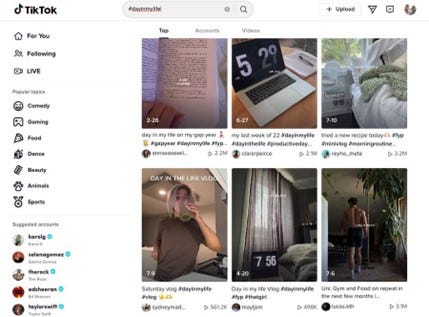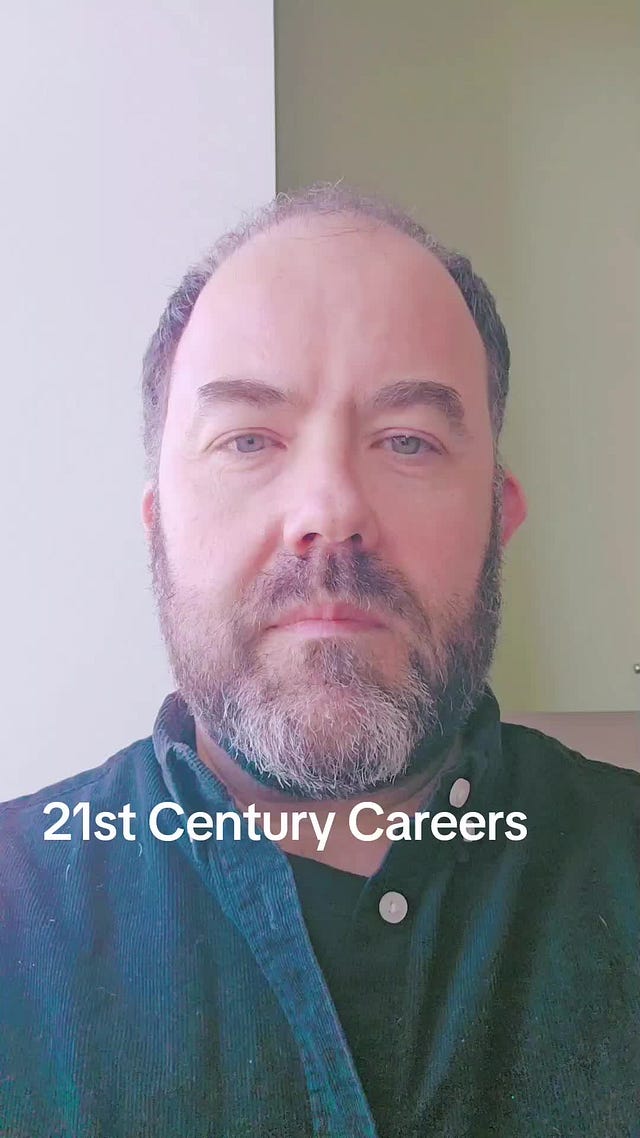The TikTokification of Work: Navigating the Video Revolution in the Future of Work
#WF53 How Video is being used to transform how employers engage with workers and candidates
Don't you wonder sometimes 'bout sound and vision?
David Bowie
Video dominates our digital consumption and comprises over 80% of global internet traffic. A third of Americans under 30 now turn to TikTok as their regular news source, a fourfold increase since 2020.
Video has rapidly migrated from amusing cat videos to catnip for humans. It is the prime medium for news, communication, and self-expression.
How is this seismic shift in video consumption impacting how employers make their brands more compelling, engage with the workforce and attract candidates?
In this article, I show some authentic employer branding stories, including from the mining industry, reveal which brand is the Queen of TikTok, highlight some accounts to follow, and showcase how companies are leveraging video to achieve outstanding results. There is also a detour into the psychology behind video's addictive allure.
(This article is also available as a Podcast🎙️)
You are reading Workforce Futurist Newsletter, if you don’t already, please consider subscribing to get new issues direct to your inbox, reply to the emails and comment below.
Your Tube - Pop Culture is all about you

The existential threat to scripted movies and streaming TV shows is not AI-generated clones of Salma Hayek, but the fact that consumer tastes have changed.
Those under 40 are much more likely to spend their time on TikTok than consume streaming content.
It turns out that people find themselves more amusing than Tom Hanks and Julia Roberts.
The Rise of TikTok and Video Dominance
The place for observing amusing humans online is TikTok.
The app features powerful recording and editing capabilities that make it easy to quickly record, edit and post short-form videos (under 1 minute).
It has grown exponentially and is expected to have 1.8 billion monthly active users worldwide by the end of 2023.
Marketers are attracted to TikTok for its emotionally rich format, potential for viral videos and young global audience.
Fun Fact - it is estimated that it would take 6.5 million days, or 17,810 years of consecutive video watching to watch all of the videos on YouTube.
YouTube started video sharing, and is responding to TikTokification with it’s own YouTube Shorts, videos up to 60 seconds long, more more user interaction.
It might be easy to dismiss TikTok as the silly ‘lipsyncing app’, but I will give some examples of where it is making an impact on business and work.
Duolingo - The Queen 👑 of TikTok
“If I had to crown one company the king of TikTok, I’d go with Duolingo.” Rex Woodbury.
Duolingo is an impressive app that helps you learn new languages. It uses some clever behavioural psychology - for example, addictive gamification, guilt trips and midnight notifications (muito obrigado amigos).
Duolingo uses short videos to try and kill off the competition from Google Translate.
Their videos are slapstick, funny, and irreverent which appeals to the demographic, but this is notoriously difficult for brands to pull off.
Duolingo’s account now has more than 10.3 million followers, for comparison, Disney has 13.7 million.
Here is an honest and insightful account from Zaria Parvez – Global Social Media Manager at Duolingo, from her conversation with Rex Woodbury.
“When we first launched our TikTok, we fell into the same trap of doing what we’ve always done and not really adapting to what people expect from content on the platform. Most of our content was product-driven or specifically about learning a language and didn’t really establish a connection with our audience. The reality is people wanted to be entertained, not sold to—and it took us failing to learn that.”
Companies need to adapt to the characteristics of the new platform and not force-fit existing methods. TikTok is a great platform for building awareness, not necessarily selling.
The first work-related phenomenon that caught my attention on TikTok was “A Day in My Life” viral videos.
A Day In My Life: Authentic Employer Branding Through Short Videos
I saw a film today, oh boy…
A Day In The Life, The Beatles
Ever wondered what it’s like working as a Paint Mixer, or a Construction Worker in the Mining Industry?

TikToks featuring the hashtags #DayInTheLife, #DayInMyLife, and #DailyVlog have had more than 50 billion views.
These are videos of about 30–120 seconds which show what it is like to work in a job role.
The first example is from the mining industry.
Tommy The Cowboy
How do you create demand for jobs in the dusty Mining Industry?
Here is a Day in the Life of a Construction Worker, FIFO, Tommy, with a 4 minute video. By the way, FIFO = Fly In Fly Out.

 Tiktok failed to load.
Tiktok failed to load.Enable 3rd party cookies or use another browser
So workers like Tommy travel to remote areas for 2 weeks straight and then fly home for a week. So imagine that you were thinking about this type of role and lifestyle, but weren’t sure. This rich explanation is more useful than any corporate website or chat with a recruiter, as you will see by skimming some of the appreciative comments.
What is the impact for the Mining Industry and FIFO jobs?
It’s hard to say, but here’s some metrics for just one video:
❤️ 521k likes
📑 29.6k bookmarks
✍🏽 4k comments
👐🏽 12.2k shares
Which is positive and inexpensive PR.
Here is another example…
Paint Shop Guy
Tony Piloseno is a part-time paint-mixer from Athens, Ohio.
He posts videos of himself mixing paint on TikTok which were very popular.
So far so colourful. Until he got fired.
For making videos during his work hours with company equipment. He has since been hired by a competitor and seems to have made paint-mixing a desirable career path.
 Tiktok failed to load.
Tiktok failed to load.Enable 3rd party cookies or use another browser
For Employers with glitzy corporate videos on the Careers section of their website, these more authentic videos give much richer and realistic views on what a potential job is like for a candidate.
These are examples of Employer Branding using video for deeper connections with potential workers.
Before I finish up with some useful resources for workforce futurists, as usual, a question :-
Video’s Psychological Appeal: Why It Works
What explains the popularity of short-form video?
According to Cognitive Psychologists, I have tried so summarise the main reasons :-
Social validation and proof - likes and shares give us social humans a sense of approval and belonging.
FOMO - “I want the latest thing, and hate to miss out.”
Cognitive Ease - it’s in your face.
Novelty Gap - viewers seek closure on the intriguing premise of the video.
Neurotransmitter reward systems - such as dopamine create a sense of pleasure and anticipation.
These processes provide some explanation to the mass appeal of video.
TikTok Tickles and Other Useful Resources
I have spent time on TikTok to find what was being said about Work and Careers.
This is a fairly busy place, some of the accounts below have 600k followers, and some of the videos have more than a million views.
For Job Seeker Tips, you can try Madeline Mann, J.T.O’Donnell (1.2m followers), Joel Lalgee, and CareerVidz (4.5m followers).
For perspective, try Gabrielle Judge - Anti Work Girlboss, and her #LazyGirlJobs, or Sinead Bovell, with sensible tips to prevent cheating with AI at school.
And for some work chuckles, try, Nikki Jaskiewicz, Your Human Resources Bestie, and Veronica Sargeant.
“In my mind and in my car, We can't rewind, we've gone too far”
Video Killed the Radio Star, by Buggles, 1979. (more on this song below in Closing Credits)
And now, maybe I have gone too far - as you can now add me too on TikTok at “Workforce_Futurist”. I will stay around for a while to see what happens…
Leveraging Video for Recruitment and Worker Engagement
In the dance of recruitment, authenticity leads. Our platform is where companies and candidates meet to exchange opportunities, connect, and envision a future together. We are in the age of 'humanized hiring,' where video is the heartbeat of genuine employer branding. Omar Khateeb, CEO, Job Pixel
The COVID-driven shift to remote work triggered a 535% spike in video conferencing overnight. Video has transcended beyond the confines of conference calls and into robust employer branding.
Amidst this "TikTokification" of the workplace video is being used to redefine the narrative of recruitment in a competitive job market. From creating content to crafting stories that echo the ethos of a workplace and resonate with potential candidates.
Companies like UScellular are already demonstrating with their worker snippets, this human-centric approach pays dividends. The welcome message from the boss is not just a greeting, but invites candidates to step into the office, even before they apply.
Employers using video are reporting tangible results, with a significant uptick in engagement. For example, JobPixel have shared that companies are reporting a 34% rise in conversion rates, and a 3x improvement in response rates, while also experiencing a 25% decrease in bounce rates.
In a landscape where 46% of young adults consume educational content online, using video also plays into the agile development of learning materials. Reducing the average training cost per learner, video facilitates the creation of concise, impactful training videos. The result is a budget-friendly learning experience that resonates with a generation that values brevity and engagement.
Final Frame
The TikTokification of work is transforming the way we learn, communicate, and engage in the professional realm. Video content has become a dominant force.
From the humorous success of Duolingo to the authentic portrayal of day-in-the-life experiences, the platform has emerged as a powerful tool for employer branding and connecting with a global audience.
As video's influence extends beyond entertainment to learning and employee engagement, organizations must adapt to this trend.
With any new technology, it’s easy to get it wrong.
With short videos that can go viral in minutes, the stakes are high.
Tips for Navigating TikTokification
Here are some things to consider :-
Keep it fun - as Duolingo found “people wanted to be entertained, not sold to…”
In Marketing jargon - think top-of-funnel, not sales.
Experiment and evaluate use of short videos.
Find agile ways to integrate video into strategies for recruitment, onboarding, and overall communication.
Don’t ignore short videos! Your workforce don’t.
Share your work video stories and tips in the comments below…
Closing Credits
“Video Killed The Radio Star” by The Buggles was the first video ever played on MTV at 12:01am on August 1, 1981 - literally the birth of the music video.
Many thanks to Omar and the team at JobPixel for insightful video chats.










Great post, as always!
👏🏼👏🏼👏🏼